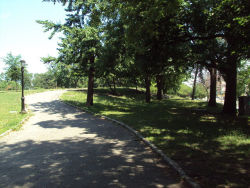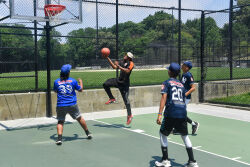Franz Sigel Park
Franz Sigel Park
Educator, soldier, journalist, and public official, Franz Sigel (1824-1902) was a patriot both in his native land of Germany and in his adopted home in the United States. Born in Sinsheim, Baden, Sigel moved to the United States after the German Revolution of 1848. After settling in New York City in 1852, he taught in public schools and German schools, co-founded the German-American Institute, joined the 5th New York Militia, and wrote for the New Yorker Staats-Zeitung and the New York Times. He moved to St. Louis in 1857 to teach at the German-American Institute.
At the outset of the American Civil War, Sigel formed a regiment that helped to keep Missouri and its Federal Arsenal for the Union. Rising to the rank of major general in the Union Army, he fought in several decisive campaigns including Pea Ridge and the Second Battle Run. Sigel returned to New York in 1867, first working in the transportation industry and then serving in various positions in local and Federal government. He returned to his career in journalism as the publisher of the New York Deutsches Volksblatt and editor of the New York Monthly.
After Sigel's death in 1902 at his home on Mott Avenue, (now the Grand Concourse), residents of Melrose and Mott Haven successfully petitioned the City Board of Aldermen to name the park bounded by 153rd Street, the Grand Concourse, Walton Avenue, and 158th Street in his memory. In 1907 Sigel's contribution to the Union victory was commemorated by sculptor Karl Bitter (1867-1915) in an equestrian statue that was erected at Riverside Drive and West 106th Street.
Franz Sigel Park also figures in early Bronx history. The west slope of the park (Walton Avenue) was once part of a path used by local Indians. During the Revolutionary War, George Washington, Count de Rochambeau, and their respective American and French military staffs, used a high rocky ridge at the site to monitor the movements of British troop camped alongside the Harlem River. In 1885 most of the land that became the park was purchased by the City of New York from Gerard and Mary Walton. The name of their estate, Cedar Grove, inspired the park's original name, Cedar Park. An additional parcel was assigned to Parks in 1943, when part of a former street was closed.
Although plans from the mid-1930s show a range of proposals for formalizing the system of circulation and for defining a central area with a building and terrace specially designed for views of the Manhattan skyline, the path system that exists today is in large part the same as existed in the early part of the century. In 1964 the park was retrofitted for active recreation with two softball fields, and a basketball court following soon after. In 1993 the public restroom was built, finally realizing the plans for a such a facility proposed nearly sixty years earlier.
Check out your park's Vital Signs
Clean & Safe
Green & Resilient
Empowered & Engaged Users
Share your feedback or learn more about how this park is part of a
Vital Park System










